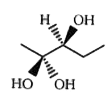Some alkyl halides undergo substitution whereas some undergo elimination reaction on treatment with bases. Discuss the structural features of alkyl halides with the help of examples which are responsible for this difference.
To understand why some alkyl halides undergo substitution reactions while others undergo elimination reactions when treated with bases, we need to consider the structural features of the alkyl halides and the nature of the bases used. Here’s a step-by-step explanation:
Step 1: Understand the Types of Reactions
Alkyl halides can undergo two main types of reactions when treated with bases:
- Substitution Reactions (SN1/SN2): In these reactions, a nucleophile replaces the halogen atom in the alkyl halide.
- Elimination Reactions (E1/E2): In these reactions, the alkyl halide loses a halogen and a hydrogen atom, resulting in the formation of a double bond.
Step 2: Identify the Role of the Base
The type of base used plays a crucial role in determining the pathway of the reaction:
- Weak Bases (e.g., aqueous KOH): Favor substitution reactions.
- Strong Bases (e.g., alcoholic KOH): Favor elimination reactions.
Step 3: Analyze the Structure of Alkyl Halides
The structure of the alkyl halide significantly influences the reaction pathway:
- Primary Alkyl Halides: Generally favor SN2 reactions due to steric accessibility. For example, in the case of methyl chloride (CH3Cl), when treated with aqueous KOH, a substitution reaction occurs, leading to the formation of methanol (CH3OH).
- Tertiary Alkyl Halides: Favor SN1 and elimination reactions due to the stability of carbocations. For example, in the case of tert-butyl chloride (C(CH3)3Cl), when treated with aqueous KOH, a substitution reaction occurs, leading to tert-butanol (C(CH3)3OH). However, when treated with alcoholic KOH, elimination occurs, resulting in the formation of 2-methylpropene.
Step 4: Mechanism of Reactions
- SN2 Mechanism: Involves a single transition state where the nucleophile attacks the carbon and the leaving group (halogen) departs simultaneously. This is typical for primary alkyl halides.
- SN1 Mechanism: Involves the formation of a carbocation intermediate. This is more favorable for tertiary alkyl halides due to their stability.
Step 5: Conclusion
The structural features of alkyl halides, such as the degree of substitution (primary, secondary, tertiary) and the nature of the base (weak or strong), dictate whether a substitution or elimination reaction will occur.
Examples:
1. Methyl Chloride (CH3Cl) with aqueous KOH → Substitution (Methanol)
2. Tert-Butyl Chloride (C(CH3)3Cl) with aqueous KOH → Substitution (Tert-Butanol)
3. Tert-Butyl Chloride (C(CH3)3Cl) with alcoholic KOH → Elimination (2-Methylpropene)
---
Alkyl halides can undergo two main types of reactions when treated with bases:
- Substitution Reactions (SN1/SN2): In these reactions, a nucleophile replaces the halogen atom in the alkyl halide.
- Elimination Reactions (E1/E2): In these reactions, the alkyl halide loses a halogen and a hydrogen atom, resulting in the formation of a double bond.
The type of base used plays a crucial role in determining the pathway of the reaction:
- Weak Bases (e.g., aqueous KOH): Favor substitution reactions.
- Strong Bases (e.g., alcoholic KOH): Favor elimination reactions.
The structure of the alkyl halide significantly influences the reaction pathway:
- Primary Alkyl Halides: Generally favor SN2 reactions due to steric accessibility. For example, in the case of methyl chloride (CH3Cl), when treated with aqueous KOH, a substitution reaction occurs, leading to the formation of methanol (CH3OH).
- Tertiary Alkyl Halides: Favor SN1 and elimination reactions due to the stability of carbocations. For example, in the case of tert-butyl chloride (C(CH3)3Cl), when treated with aqueous KOH, a substitution reaction occurs, leading to tert-butanol (C(CH3)3OH). However, when treated with alcoholic KOH, elimination occurs, resulting in the formation of 2-methylpropene.
- SN2 Mechanism: Involves a single transition state where the nucleophile attacks the carbon and the leaving group (halogen) departs simultaneously. This is typical for primary alkyl halides.
- SN1 Mechanism: Involves the formation of a carbocation intermediate. This is more favorable for tertiary alkyl halides due to their stability.
The structural features of alkyl halides, such as the degree of substitution (primary, secondary, tertiary) and the nature of the base (weak or strong), dictate whether a substitution or elimination reaction will occur.
1. Methyl Chloride (CH3Cl) with aqueous KOH → Substitution (Methanol)
2. Tert-Butyl Chloride (C(CH3)3Cl) with aqueous KOH → Substitution (Tert-Butanol)
3. Tert-Butyl Chloride (C(CH3)3Cl) with alcoholic KOH → Elimination (2-Methylpropene)
Topper's Solved these Questions
- HALOALKANES AND HALOARENESBook:NCERT EXEMPLAR ENGLISHChapter:HALOALKANES AND HALOARENESExercise:Assertion & Reason
Explore 10 Videos
- GENERAL PRINCIPLE AND PROCESSES OF ISOLATION OF ELEMENTS Book:NCERT EXEMPLAR ENGLISHChapter:GENERAL PRINCIPLE AND PROCESSES OF ISOLATION OF ELEMENTS Exercise:Long Answer Type Questions
Explore 1 Video
- P-BLOCK ELEMENTSBook:NCERT EXEMPLAR ENGLISHChapter:P-BLOCK ELEMENTSExercise:Long Answer Type Questions
Explore 3 Videos
Similar Questions
Knowledge Check
The compound shown in the below undergoes racemization on reaction with aqueous acid.

Which of the following structures best represents the intermediate responsible for this process ?A B
B C
C D
D
Which of the following alkyl halide undergo rearrangement in SN1 reaction ?
ACH3−CH3∣C∣CH3−C∣IH−CH3B C
C DAll of these
DAll of theseWhich of the following statement is not correct about SN2 reactions of alkyl halides?
ANucleophile attacks the carbon from the side opposite to where the leaving group is attached.BThe bond formation and bond breaking take place in one step.CThe rate of reaction depends upon the concentration of nucleophile.DSN2 mechanism is predominant in tertiary alkyl halides.
1∘ alkyl halides preferably undergo which of the following mechanism ?
View SolutionWhich of the following is an example of aryl alkyl halide ?
View SolutionA primary alkyl halide would prefer to undergo :-
View SolutionWhich of the following halides undergo E2 elimination?
View SolutionAryl halides are less reactive towards nucleophilic substitution reaction as compared to alkyl halides due to
View Solution

